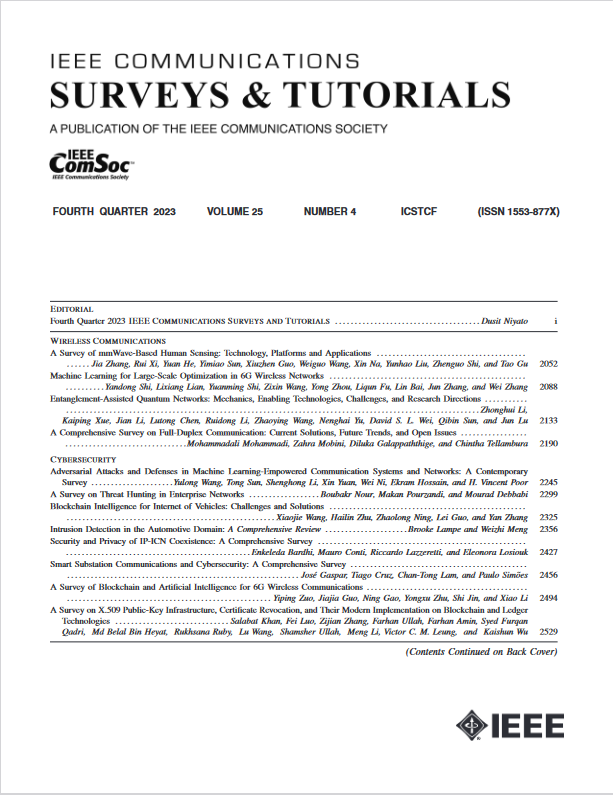确保物联网身份的硬件安全
IF 34.4
1区 计算机科学
Q1 COMPUTER SCIENCE, INFORMATION SYSTEMS
引用次数: 0
摘要
随着物联网(IoT)设备的激增,人们越来越需要优先考虑其安全性,特别是在身份和认证机制方面。然而,物联网设备在计算能力和易受硬件攻击方面有其独特的局限性,这给建立强大的身份和认证系统带来了巨大挑战。矛盾的是,造成这些挑战的硬件限制也可以提供潜在的解决方案。通过采用基于硬件的身份识别实施,有可能克服计算和能源限制,同时增强抵御硬件和软件攻击的能力。本研究通过调查物联网背景下身份和认证系统面临的漏洞和障碍来应对这些挑战,同时还探索了解决这些问题的潜在技术。每项确定的技术都经过了细致的调查,考虑了已知的安全攻击、已实施的应对措施以及对其利弊的评估。此外,还进行了广泛的文献调查,以确定这些技术有效支持设备身份识别的实例。研究还包括一个演示,评估硬件信任锚在减轻对物联网身份的各种攻击方面的有效性。这一实证评估为开发人员在实施基于硬件的身份识别解决方案时遇到的挑战提供了宝贵的见解。此外,它还强调了这些解决方案在减轻攻击和开发强大身份框架方面的巨大价值。通过彻底检查漏洞、探索技术和进行实证评估,本研究有助于理解和促进在安全的物联网环境中采用基于硬件的身份和认证系统。研究结果强调了开发人员面临的挑战,并突出了硬件信任锚在增强安全性和促进有效身份解决方案方面的重要性。本文章由计算机程序翻译,如有差异,请以英文原文为准。
Hardware Security for Internet of Things Identity Assurance
With the proliferation of Internet of Things (IoT) devices, there is an increasing need to prioritize their security, especially in the context of identity and authentication mechanisms. However, IoT devices have unique limitations in terms of computational capabilities and susceptibility to hardware attacks, which pose significant challenges to establishing strong identity and authentication systems. Paradoxically, the very hardware constraints responsible for these challenges can also offer potential solutions. By incorporating hardware-based identity implementations, it is possible to overcome computational and energy limitations, while bolstering resistance against both hardware and software attacks. This research addresses these challenges by investigating the vulnerabilities and obstacles faced by identity and authentication systems in the IoT context, while also exploring potential technologies to address these issues. Each identified technology underwent meticulous investigation, considering known security attacks, implemented countermeasures, and an assessment of their pros and cons. Furthermore, an extensive literature survey was conducted to identify instances where these technologies have effectively supported device identity. The research also includes a demonstration that evaluates the effectiveness of hardware trust anchors in mitigating various attacks on IoT identity. This empirical evaluation provides valuable insights into the challenges developers encounter when implementing hardware-based identity solutions. Moreover, it underscores the substantial value of these solutions in terms of mitigating attacks and developing robust identity frameworks. By thoroughly examining vulnerabilities, exploring technologies, and conducting empirical evaluations, this research contributes to understanding and promoting the adoption of hardware-based identity and authentication systems in secure IoT environments. The findings emphasize the challenges faced by developers and highlight the significance of hardware trust anchors in enhancing security and facilitating effective identity solutions.
求助全文
通过发布文献求助,成功后即可免费获取论文全文。
去求助
来源期刊

IEEE Communications Surveys and Tutorials
COMPUTER SCIENCE, INFORMATION SYSTEMS-TELECOMMUNICATIONS
CiteScore
80.20
自引率
2.50%
发文量
84
审稿时长
6 months
期刊介绍:
IEEE Communications Surveys & Tutorials is an online journal published by the IEEE Communications Society for tutorials and surveys covering all aspects of the communications field. Telecommunications technology is progressing at a rapid pace, and the IEEE Communications Society is committed to providing researchers and other professionals the information and tools to stay abreast. IEEE Communications Surveys and Tutorials focuses on integrating and adding understanding to the existing literature on communications, putting results in context. Whether searching for in-depth information about a familiar area or an introduction into a new area, IEEE Communications Surveys & Tutorials aims to be the premier source of peer-reviewed, comprehensive tutorials and surveys, and pointers to further sources. IEEE Communications Surveys & Tutorials publishes only articles exclusively written for IEEE Communications Surveys & Tutorials and go through a rigorous review process before their publication in the quarterly issues.
A tutorial article in the IEEE Communications Surveys & Tutorials should be designed to help the reader to become familiar with and learn something specific about a chosen topic. In contrast, the term survey, as applied here, is defined to mean a survey of the literature. A survey article in IEEE Communications Surveys & Tutorials should provide a comprehensive review of developments in a selected area, covering its development from its inception to its current state and beyond, and illustrating its development through liberal citations from the literature. Both tutorials and surveys should be tutorial in nature and should be written in a style comprehensible to readers outside the specialty of the article.
 求助内容:
求助内容: 应助结果提醒方式:
应助结果提醒方式:


